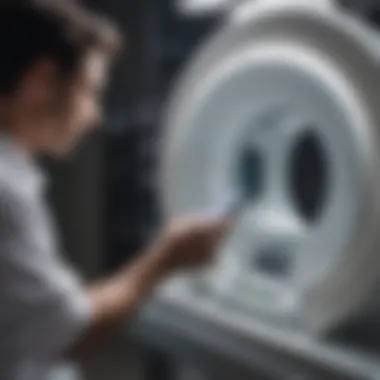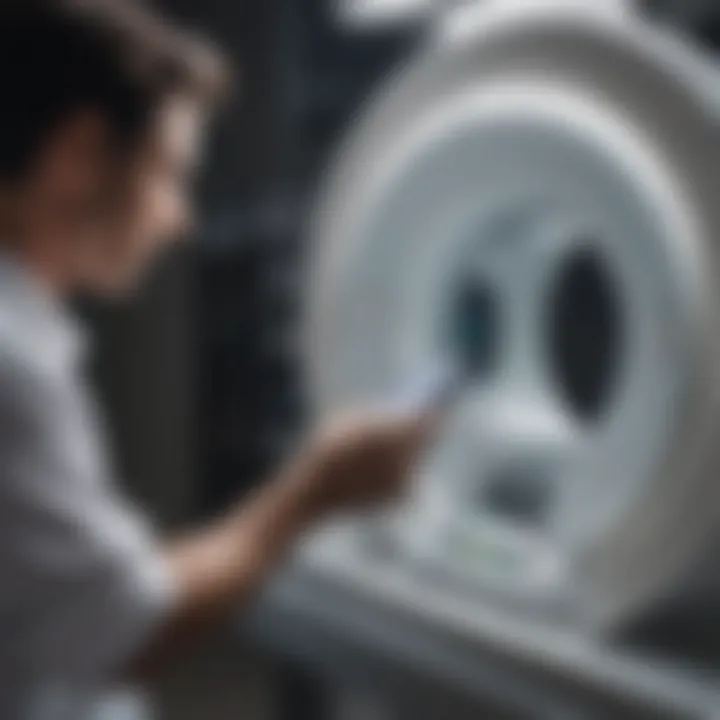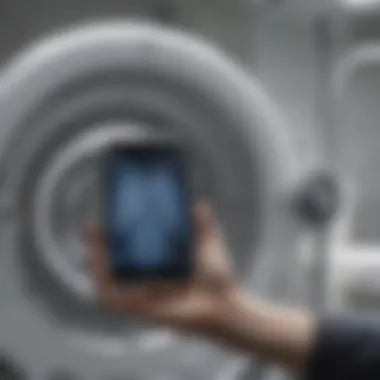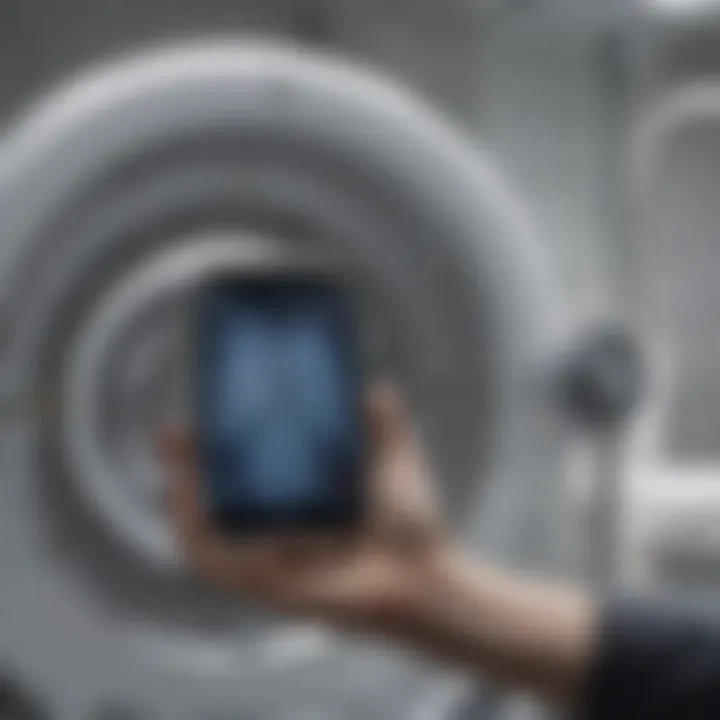Handheld MRI Devices: Innovations and Implications


Intro
The medical imaging field has faced significant challenges in providing timely and accurate diagnostics. Handheld MRI devices represent a notable shift towards addressing these challenges. The evolution of these devices offers new possibilities for healthcare settings, especially in outpatient and emergency situations. Their portability and ease of use allow for imaging capabilities that were previously limited to traditional and more cumbersome MRI machines. This ability can fundamentally alter how medical professionals diagnose conditions and make immediate decisions on treatment.
In this article, we will investigate the innovations brought forth by handheld MRI technology, the implications for clinical practice, and the ethical concerns that arise. With a focus on current trends and future directions, this discussion will provide a thorough understanding of the significance of these devices in contemporary medicine.
Methodology
Overview of research methods used
The exploration of handheld MRI devices involved a comprehensive review of existing literature and analysis of case studies. This approach enabled an understanding of the current state of technology, its implementation in clinical settings, and patient outcomes. Key sources included peer-reviewed journals, industry reports, and interviews with medical professionals actively using the devices.
Data collection techniques
Data collection for this study was achieved through multiple techniques:
- Surveys: Conducted among healthcare professionals who use handheld MRI devices to gather insights regarding their experience and effectiveness.
- Observation: Direct observation of the devices in live clinical environments provided valuable information on usability and integration into workflow.
- Literature review: Studying previous research helped in identifying trends, advantages, and challenges associated with handheld MRI technology.
The methodological approach ensured that the findings are robust and reflect a diverse range of perspectives in the medical imaging sector.
Future Directions
Upcoming trends in research
As handheld MRI technology continues to evolve, future research will likely focus on several key areas, including:
- Enhanced imaging capabilities: Continuous improvements in imaging resolution and speed will be essential for diagnostic accuracy.
- Software integration: Research will investigate how artificial intelligence can aid in image analysis and interpretation, streamlining the diagnostic process.
- Cost-effectiveness: Studies will analyze the economic impact of these devices on healthcare systems, examining potential cost savings and resource allocation.
Areas requiring further investigation
While innovations are promising, several areas need more attention:
- Training and acceptance: The training of medical professionals in utilizing handheld MRI technology needs to be evaluated to ensure widespread acceptance in clinical practice.
- Health equity: Future research should explore how the adoption of handheld MRI devices can contribute to reducing health disparities, particularly in underserved populations.
Understanding these factors will help to shape the future landscape of medical imaging, ensuring that handheld MRI devices are used to their fullest potential in improving patient care.
Foreword to Handheld MRI Technology
Handheld MRI technology signifies a transformative evolution within the medical imaging landscape. Its development addresses pressing needs in various clinical environments, from emergency rooms to outpatient facilities. As healthcare continues to strive for improved patient outcomes, the significance of handheld MRI devices comes into sharp focus. The potential to facilitate timely imaging without the constraints of traditional MRI systems makes them valuable tools in modern medicine.
This section will delineate an overview of MRI technology itself and will address the pressing need for adopting handheld devices in clinical practice.
Overview of MRI Technology
Magnetic Resonance Imaging (MRI) is a non-invasive imaging technique that employs strong magnetic fields and radio waves to produce detailed images of the internal structures of the body. The primary advantage of MRI lies in its ability to generate high-resolution images without the use of ionizing radiation, making it safer than other imaging modalities like X-rays or CT scans.
The basic principle involves aligning the hydrogen nuclei of atoms in the body using a magnetic field. When exposed to radiofrequency energy, these nuclei emit signals that are translated into images. Standard MRI systems are typically large, expensive, and operate within dedicated facilities, which can complicate fast and responsive patient care. Traditional systems require extensive infrastructure and can lead to increased wait times, particularly in acute care situations.
The Need for Handheld Devices
The introduction of handheld MRI devices arises from vital clinical needs. In many medical scenarios, immediate access to imaging can influence treatment decisions and improve patient outcomes. Handheld devices promise to bridge the gap when speed and efficiency are essential. They offer:
- Portability, allowing for imaging at the patient's bedside or remote locations.
- Rapid diagnosis, essential in conditions where time is of the essence, such as trauma or stroke.
- Automation aspect, potentially simplifying the imaging process and minimizing the need for extensive training.
The versatility of handheld MRI devices notably addresses the challenges faced by traditional systems. These include long set-up times, cumbersome equipment, and limited accessibility in critical care settings. The portability of handheld devices provides unique solutions for rural and underserved areas where access to advanced imaging technology may be scarce. This innovation is crucial for enhancing patient care in various healthcare environments, marking a significant evolution in medical imaging.
Technical Specifications of Handheld MRI Devices
Understanding the technical specifications of handheld MRI devices is crucial for grasping their potential impact on medical imaging. These specifications determine device performance, usability in various settings, and overall diagnostic capabilities. Key elements include the types of magnets used, imaging capabilities, and how these devices operate with their power sources. Each of these factors plays a significant role in making handheld MRI devices suitable for clinical adoption.
Magnet Types and Strengths


The type of magnet used in handheld MRI devices is a central element in their functioning. These devices typically use either permanent magnets or superconducting magnets. Permanent magnets are lighter and require less power, making them more suitable for handheld applications. They provide sufficient magnet strength for many diagnostic procedures, although their imaging quality can vary.
Superconducting magnets, however, offer superior imaging capabilities. They produce a stronger magnetic field, resulting in clearer images. The trade-off is their need for liquid helium to maintain superconductivity, which complicates portability. Each type has its advantages, and the choice often depends on the required imaging quality and the typical environment where the device will be used.
"The strength of the magnet directly influences the resolution and clarity of MRI images, impacting the accuracy of diagnoses."
Imaging Capabilities
Imaging capabilities of handheld MRI devices encompass a range of technological advancements. These devices aim for high-resolution imaging while remaining compact. Manufacturers are integrating advanced software algorithms to enhance image processing. Improved algorithms enable faster scans with less motion artifacts, which is essential for maintaining image quality in portable devices.
The methods to acquire images also differ. Some handheld devices utilize 2D imaging techniques, while others may offer 3D imaging capabilities. Each imaging method serves distinct clinical purposes. For instance, 3D images can be vital for complex cases requiring comprehensive neuronal evaluations, while 2D images suffice for more straightforward assessments.
Power Sources and Portability
Power sources significantly influence the design and usability of handheld MRI machines. The most common sources are battery-operated systems, which enhance mobility but may limit scanning time. Recent innovations have led to the development of hybrid power systems that combine battery and wall outlet options. This flexibility appeals to medical professionals working in various settings, as they need devices that adapt to their environment.
Portable MRI devices often prioritize lightweight construction. This design is paramount as it allows the device to be maneuvered easily in tight spaces, such as in ambulances or remote clinics. Additionally, integration of portable power solutions enhances operational efficiency, meaning that medical practitioners can utilize these machines without worrying about finding immediate power sources.
In summation, the technical specifications of handheld MRI devices lay the groundwork for their functionality and adaptability in clinical environments. Precise knowledge of magnet types, imaging capabilities, and power sources helps healthcare professionals leverage these devices effectively.
Applications in Clinical Settings
The integration of handheld MRI devices in clinical settings marks a turning point in medical imaging. Their versatility enables medical professionals to perform rapid assessments in various environments, enhancing patient care across multiple scenarios. The advantages are manifold, as these devices are not only designed for efficiency but also aim to improve accessibility to advanced imaging techniques, which can be life-changing in urgent medical contexts.
Outpatient Care
In outpatient care, the handheld MRI technology proves particularly beneficial. These devices allow for immediate scans during patient visits, greatly reducing the need for follow-up appointments. For many patients with chronic conditions or follow-up requirements, this accessibility provides significant comfort and convenience.
Key points related to outpatient applications include:
- Efficiency: Quick imaging supports timely treatment decisions.
- Cost-effective: Reduced overheads associated with extensive facilities.
- Patient Engagement: Allows for direct dialogue between patient and physician following imaging, facilitating a better understanding of medical findings.
The incorporation of handheld MRI into routine outpatient practice not only streamlines operations but also enhances patient satisfaction due to decreased waiting times.
Emergency Medicine
In emergency medicine, the role of handheld MRI devices becomes even more critical. These devices can swiftly provide essential imaging data that influences life-saving decisions. When speed is of the essence, handheld machines can deliver diagnostic images on the spot, allowing for immediate response to conditions such as strokes or trauma injuries.
Important factors in emergency settings include:
- Rapid Diagnosis: Minutes can save lives; thus, quick imaging is essential.
- Portability: The ability to transport devices easily between units or at disaster sites.
- Real-time Data: Emergency teams can make informed decisions based on current data.
Given the unpredictable nature of emergencies, having access to portable MRI technology enables healthcare professionals to assess injuries accurately, enhancing the chances of positive outcomes for patients.
Remote and Resource-Limited Areas
Handheld MRI devices also hold transformative potential for healthcare in remote and resource-limited areas. Traditional MRI machines are not always available in rural clinics or under-resourced hospitals. Handheld devices can bridge this gap by providing critical imaging data where conventional methods fall short.
Considerations for these contexts include:
- Accessibility: Makes medical imaging accessible to underserved populations.
- Affordability: Often associated with reduced costs compared to stationary units.
- Training: Simplified operation allows for easier training of local medical personnel.
These advantages collectively enhance diagnostic capabilities in diverse environments, proving that technology can democratize healthcare access more effectively than traditional imaging systems.
"Handheld MRI represents a new frontier in medical imaging, particularly in areas previously isolated from quality healthcare services. It's about giving access where it matters most."
In summary, the applications of handheld MRI devices in various clinical settings enhance patient outcomes, streamline healthcare processes, and expand access to essential imaging services. As the technology advances, its role in reshaping medical practice is likely to increase, promising a future where quality care is more universally available.
Advantages of Handheld MRI Devices
Handheld MRI devices represent a transformative leap in medical imaging. The advantages of these devices extend beyond mere convenience; they address critical factors in patient care, diagnosis speed, and overall healthcare delivery. Understanding these advantages can illuminate why handheld MRI technology has become a focal point in medical innovation.


Accessibility and Convenience
Handheld MRI devices significantly enhance accessibility to diagnostic imaging. Traditional MRI machines are often confined to hospitals or specialized imaging centers. The mobility of handheld devices allows for their use in a variety of settings, including clinics, emergency rooms, and even remote locations. This capability makes imaging more accessible to patients who might face obstacles in reaching conventional MRI facilities.
In addition, the simplicity of operation is another advantage. With user-friendly interfaces, medical professionals can quickly adopt these devices without extensive training. This fosters efficient workflows in busy clinical environments, allowing practitioners to focus on patient care rather than navigating complex technologies.
"Handheld MRI devices allow quick imaging that can save time and improve patient outcomes."
Speed of Diagnosis
The rapidity with which handheld MRI devices can produce scans is a key factor in their effectiveness. In urgent scenarios, such as emergency medical situations, faster access to imaging results can critically influence treatment decisions. Handheld MRIs provide near-instantaneous imaging, which allows doctors to quickly assess conditions such as fractures, hemorrhages, or internal injuries.
This sped-up process has the potential to reduce the time patients wait for diagnoses. Under conventional practices, waiting for an MRI scan and interpretation can be tedious. By streamlining this process, handheld devices empower healthcare professionals to take immediate action based on real-time data.
Patient Experience Improvement
Perhaps one of the most vital improvements brought forth by handheld MRI devices is the enhancement of the patient experience. Traditional MRI procedures often involve lengthy waits, claustrophobic environments, and the requirement to remain still for extended periods. In contrast, handheld devices offer less intimidating experiences, as many scans can be performed in a more relaxed, informal setting.
Moreover, the potential for decreased wait times and expedited consultations can lead to improved patient satisfaction. The ability to receive immediate feedback on their condition alleviates anxiety for many patients. With handheld MRIs, patients are not only receiving more efficient care, but they also engage more positively with their healthcare providers, fostering trust and communication.
Challenges and Limitations
The integration of handheld MRI devices into clinical settings must contend with several challenges and limitations. Understanding these issues is critical for fully appreciating the implications of this technology. Each challenge can impact device effectiveness and acceptance amongst healthcare professionals.
Image Quality Reconciliation
One of the primary hurdles faced with handheld MRI devices revolves around achieving satisfactory image quality. Traditional MRI machines provide high-resolution images by leveraging large magnets and advanced imaging protocols. However, the compact nature of handheld devices often means compromises in magnet strength and imaging capabilities. This limitation directly affects the clarity and diagnostic utility of the images produced.
Healthcare providers must balance the need for portability with the necessity for adequate image quality. Collaboration between engineers and radiologists is essential to innovate imaging algorithms and software that enhance image resolution without requiring significant increases in device size. Such improvements can lead to more reliable diagnoses, thereby increasing the utility of handheld MRIs in various clinical situations.
Regulatory Approval Processes
Navigating the regulatory landscape is another significant challenge. Handheld MRI devices must meet rigorous standards set by authorities such as the U.S. Food and Drug Administration (FDA) before they can be used in medical settings. The approval process is often complicated, requiring extensive clinical trials to prove safety and efficacy. This process can delay technology deployment, even when the innovation holds potential for substantial patient care improvements.
The necessity for thorough testing is crucial to ensure that these devices do not compromise patient safety. However, it can also stifle innovation. Developers may require more streamlined pathways for approval to help bring these devices into practice more efficiently. Advocacy for regulatory reform tailored to new technology types could be beneficial in expediting the approval of handheld MRI devices.
Training for Medical Professionals
Lastly, extensive training for medical professionals is vital to ensure the effective use of handheld MRI devices. As these devices innovate imaging processes, healthcare providers must adapt to new workflows and imaging techniques. Without adequate education and hands-on training, the potential of handheld MRI technology may not be fully realized.
Program developers should consider developing standardized training programs that focus on the unique aspects of handheld MRI usage. These programs should cover operational procedures, diagnostic interpretation, and troubleshooting common technical issues. Implementing such training initiatives will enhance the competency and confidence of healthcare providers, ultimately improving patient outcomes.
"As handheld MRI continues to evolve, addressing these challenges is vital for its success in clinical practice."
Current Research and Developments
Handheld MRI devices have sparked considerable interest in the medical imaging field. Current research focuses on improving the design and applications of these devices. Understanding these developments is important for grasping how handheld MRIs can enhance clinical practices.
Innovative Designs and Prototypes
Many researchers aim to create more versatile and user-friendly handheld MRI devices. Some innovative designs include compact systems that utilize novel magnet technologies. These new prototypes are designed to fit seamlessly into various healthcare settings. For instance, devices that are lighter and more portable can be essential in emergency situations. Their effectiveness in producing high-quality images is a key area of research. Technical advancements allow for better performance while maintaining a compact size.
Materials such as lightweight composites are being studied to enhance portability. Researchers also explore software improvements that optimize imaging processes. Adapting the user interface for medical professionals is another focus. Ultimately, these designs aim to improve usability in diverse environments.
Collaboration with Tech Companies
Collaboration between medical researchers and technology firms plays a crucial role in advancing handheld MRI devices. Tech companies bring expertise in software development and hardware engineering. This partnership leads to innovations that enhance device functionality. For example, integrating artificial intelligence can improve image analysis and diagnostics.
Additionally, joint ventures often result in cost-effective solutions for healthcare institutions. This collaboration also addresses the scalability of the devices for broader adoption. Involving tech companies ensures that the innovations are practical and meet real-world needs.
Clinical Trials and Findings


Clinical trials represent an essential phase in the development of handheld MRI technology. These trials evaluate the effectiveness, safety, and practicality of new devices in real clinical settings. Findings from these studies provide critical data on diagnostic accuracy compared to traditional MRI systems. Participants often include both patients and healthcare professionals using the devices in various scenarios.
The results can lead to refined imaging protocols and better training materials for practitioners. Furthermore, successful trials pave the way for regulatory approvals and broader market availability. It is crucial that ongoing research feeds into this framework, ensuring that clinical applications are evidence-based.
Innovation in handheld MRI devices can transform how medical practitioners diagnose and treat patients. Continuous research and collaboration are key to this evolution.
Future Directions in Handheld MRI Technology
The evolution of handheld MRI technology represents a crucial phase in medical imaging. Understanding future directions in this field helps uncover the potential benefits and challenges that lies ahead.
Integration with Telemedicine
The fusion of handheld MRI devices with telemedicine is significant for several reasons. First, it can enhance diagnostic capabilities in remote areas. When specialists cannot be present onsite, handheld MRI can provide necessary imaging that doctors can access in real time. This allows for quicker decision-making and appropriate treatment, especially in urgent cases.
Challenges lie in achieving consistent communication between the device and telemedicine platforms. Data transmission must be secure and reliable to protect patient information. Integrating cloud-based systems can aid this process by allowing for efficient access and storage of scanned images. By employing encrypted channels, healthcare providers can ensure patient privacy while utilizing these advanced technologies.
Handheld MRI, connected to telemedicine, can also facilitate global collaborations among medical professionals. Specialists from different parts of the world can evaluate findings remotely, sharing insights that enhance clinical outcomes. Such integration is not only a technological improvement but also a significant shift in how healthcare can be delivered.
Improvements in Device Functionality
Enhancing the core functionalities of handheld MRI devices is essential for their future success. Multiple factors contribute to this enhancement. Key elements include optimizing image resolution, reducing scan times, and increasing battery life. As devices become more powerful, they may offer clearer images that are necessary for accurate diagnosis, even in challenging conditions.
Another vital consideration is user interface design. A more intuitive design can reduce the time needed for training healthcare professionals, which is critical in emergency scenarios. Keeping the pathways clear and the access straightforward can improve both efficiency and user satisfaction.
Additionally, ongoing research on the use of novel materials, such as advanced magnets and compact hardware, can further support miniaturization. This not only improves portability but also aligns with the increasing demand for mobile healthcare solutions.
Overall, the direction of handheld MRI technology points towards greater usability, improved image quality, and seamless integration with contemporary medical practices.
Ethical Considerations
The emergence of handheld MRI devices has opened new pathways in medical imaging, but it also raises critical ethical considerations. As these technologies develop and become integrated into clinical practice, understanding the ethical implications is vital. Key aspects such as patient privacy, data security, and the necessity for informed consent must be thoroughly examined and addressed to maintain public trust and ensure the responsible use of these advancements.
Patient Privacy and Data Security
With the use of handheld MRI devices, one significant concern is protecting patient privacy. These devices, by their nature, collect sensitive health information during imaging. This data may include patient identifiers, medical history, and imaging results. To mitigate risks associated with data breaches, manufacturers and healthcare providers need to implement stringent security measures.
"Effective data protection is essential not only for compliance but also for maintaining patient trust."
In recent years, cyber threats have escalated, exposing healthcare systems to potential breaches. Ensuring data encryption, secure transmission protocols, and robust access controls are practices that should become standard across all handheld MRI applications. Furthermore, personnel training on handling patient data securely is essential, emphasizing that everyone involved in the MRI process understands and adheres to these protections. Providers must remain vigilant in updating their security measures to respond to evolving threats.
Informed Consent in Outpatient Settings
Informed consent is another critical ethical consideration when using handheld MRI technology, particularly in outpatient settings. Patients should fully understand what the procedure entails, including potential risks and benefits.
When a handheld MRI device is used in a less formal environment, the requirements for obtaining consent may differ. It is essential that healthcare professionals clearly explain how the device works, the type of information it gathers, and the implications of that information.
A comprehensive consent process includes:
- Clear communication about the procedure
- Discussion of the necessity and purpose of the scan
- Explanation of data handling and sharing protocols
- Assurance that patients can withdraw consent at any time
Transparency is key here—patients should not feel rushed into consenting or misinformed. The ethical obligation of the provider is to ensure patients are not only acknowledging consent but are also made aware that their medical data may have wider implications, such as being shared for research or other clinical uses. This careful consideration maintains respect for patient autonomy and aligns with ethical standards in healthcare.
Culmination
In this article, we have thoroughly explored the advancements and implications of handheld MRI devices. These tools represent a significant evolution in medical imaging technology. The ability to conduct MRI scans in a portable and accessible format brings numerous benefits to healthcare.
Summarizing Key Points
To summarize, handheld MRI devices offer:
- Enhanced Accessibility: They allow for imaging in various settings, including clinics and remote locations.
- Improved Patient Experience: The convenience of handheld devices can lessen patient anxiety and increase satisfaction compared to traditional MRI machines.
- Rapid Diagnosis: These devices can provide quick scans, which is crucial in emergency situations or when immediate action is needed.
- Technological Innovations: Continuous research is leading to better imaging quality and device functionality, making handheld MRIs a vital asset for healthcare providers.
"The portable MRI holds the potential to change how medical imaging is conducted, making it faster and more accessible to patients." – Medical Imaging Expert
Looking Ahead
Looking to the future, several elements will shape the next developments in handheld MRI technology:
- Integration with Telemedicine: As telemedicine grows, combining handheld MRI with remote diagnostics will be essential. This connectivity can assist healthcare professionals in making informed decisions without being physically present with the patient.
- Focus on Device Improvement: Research is ongoing regarding new materials, better magnet technologies, and optimized imaging algorithms. These advancements will likely address current limitations, such as image clarity and regulatory hurdles.
- Ethical Considerations: As technology progresses, ongoing discussions about patient privacy and informed consent will be critical. Safeguarding patient information while offering the capabilities of handheld MRIs must be prioritized.







